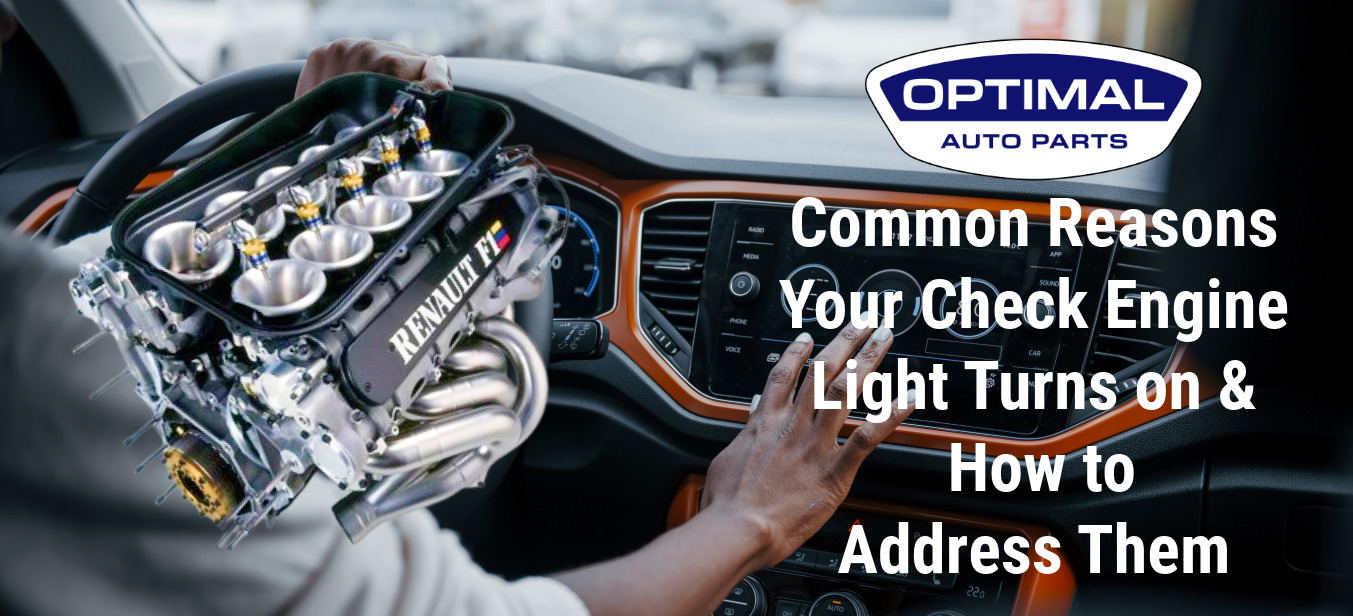Common Reasons Your Check Engine Light Turns on and How to Address Them

Table of Contents
- Introduction
- What Does the Check Engine Light Mean?
- Common Reasons Your Check Engine Light Turns On
- What to Do When Your Check Engine Light Turns On
- Frequently Asked Questions (FAQs)
Introduction
The check engine light is one of the most dreaded dashboard indicators. Seeing your check engine light on can be both confusing and alarming, especially when you’re unsure what’s causing the issue. Understanding why this light turns on and knowing how to address the underlying problem can save you time, money, and stress.
In this blog, we will explore the common reasons behind a check engine light turning on and provide actionable tips to handle the situation effectively.
Ready to find the perfectly used Ford engine at the best price?
What Does the Check Engine Light Mean?
The check engine light is part of your car’s onboard diagnostics system. When this light turns on, it indicates that the system has detected an issue that needs attention. The causes can range from minor issues, such as a loose gas cap, to major mechanical problems like a failing catalytic converter.
Ignoring a check engine light on could lead to severe engine damage, decreased fuel efficiency, or even safety hazards. Therefore, it’s essential to diagnose and resolve the issue promptly.
Common Reasons Your Check Engine Light Turns On
-
Loose or Faulty Gas Cap
The gas cap seals the fuel system and helps maintain the pressure within. A loose or damaged gas cap can trigger the check engine light. It’s an easy fix—tighten the cap or replace it if needed.
-
Faulty Oxygen Sensor
The oxygen sensor monitors the level of unburned oxygen in the exhaust system. A malfunctioning oxygen sensor can reduce fuel efficiency and increase emissions, causing the check engine light on. Replacing the sensor usually resolves the issue.
-
Malfunctioning Catalytic Converter
The catalytic converter reduces harmful emissions by converting toxic gases into less harmful substances. A failing converter often results from neglecting other issues, such as a faulty oxygen sensor, and will turn the check engine light on. Repairing or replacing the catalytic converter can be costly but is necessary for your car’s health.
-
Bad Spark Plugs or Ignition Coils
Faulty spark plugs or ignition coils can cause misfires, reducing engine performance and triggering the check engine light. Regular maintenance and timely replacement of these components can prevent such issues.
-
Faulty Mass Airflow Sensor
The mass airflow sensor measures the amount of air entering the engine to ensure proper fuel-to-air ratio. If it malfunctions, your engine may not perform optimally, leading to the check engine light on. Cleaning or replacing the sensor can fix the issue.
-
Exhaust Gas Recirculation (EGR) Valve Issues
The EGR valve recirculates a portion of exhaust gases back into the engine for improved efficiency and reduced emissions. A clogged or malfunctioning EGR valve can cause rough idling and trigger the check engine light. Cleaning or replacing the valve can resolve the problem.
-
Transmission Problems
Issues with the transmission system can sometimes cause the check engine light to turn on. This might include problems with fluid levels, solenoids, or other components. A professional diagnostic is necessary to pinpoint the exact cause.
-
Electrical or Wiring Issues
Faulty wiring or damaged sensors can send incorrect signals to the car’s computer, causing the check engine light to illuminate. An experienced technician can identify and repair the electrical issue.
What to Do When Your Check Engine Light Turns On
-
Don’t Panic
While the check engine light on can be alarming, many issues are minor and easy to fix.
-
Check the Gas Cap
Ensure your gas cap is tightened securely.
-
Scan for Trouble Codes
Use an OBD-II scanner to retrieve diagnostic trouble codes (DTCs) and understand the cause.
-
Visit a Mechanic
If you can’t identify the issue or lack the tools, consult a professional mechanic to diagnose and address the problem.
-
Avoid Procrastination
Ignoring the check engine light can lead to bigger issues and costly repairs.
The check engine light serves as a critical warning system for your vehicle. When it lights uplights on, it’s important to take it seriously, diagnose the problem, and address it promptly. Common causes include loose gas caps, faulty sensors, and more severe issues like a malfunctioning catalytic converter or transmission problems.
Staying proactive with regular vehicle maintenance can help you avoid seeing the check engine light in the first place. However, if it does illuminate, follow the steps mentioned in this guide to ensure your car stays in optimal condition.
By understanding the common reasons your check engine light turns on and how to address them, you can drive confidently and maintain your vehicle’s health for years to come.
Ready to find the perfectly used Ford engine at the best price?
Frequently Asked Questions (FAQs)

A blinking check engine light usually indicates a serious issue, such as a misfire, which could damage the catalytic converter. Stop driving immediately and seek professional help.

While you can drive for a short distance, it’s best to diagnose and address the issue as soon as possible to avoid further damage.

The cost varies depending on the problem. It can range from a few dollars for a loose gas cap to hundreds or thousands for a catalytic converter replacement.
Play to listen to this blog
Recommended Reads
- Where Should I Buy Used Engine and Used Transmissions in the USA?
- Step-by-Step Instructions for Checking Your Car Engine Oil Levels
- How to Exchange a Part of a Car on Finance – Optimal auto Part